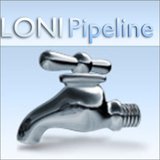![header=[] body=[<b>Location: </b>Los Angeles, United States] cssheader=[boxoverTooltipHeader] cssbody=[boxoverTooltipBody] delay=[200] Us](/images/famfamfam_flags/us.png?1680607579) User: Pipeline
User: Pipeline
 |
Name: Pipeline Joined: Tuesday 05 April 2011 21:06:36 (UTC) Last seen: Thursday 10 October 2013 16:43:54 (UTC) Email (public): Not specified Website: http://pipeline.loni.usc.edu/ Location: Los Angeles, United States |
Pipeline has been credited 23 times Pipeline has an average rating of: 0.0 / 5 (0 ratings in total) for their items |
Description/summary not set
Other contact details:
Ivo Dinov
Interests:
Not specifiedField/Industry: Not specified
Occupation/Role(s): Not specified
Organisation(s):
Not specifiedNote: some items may not be visible to you, due to viewing permissions.
Workflow
 BayesAss+ estiamtion of populations migrat...
(1)
BayesAss+ estiamtion of populations migrat...
(1)
Created: 2012-03-08
Credits:
 Pipeline
Pipeline
Workflow
 Fdist2 Simulation Pipeline Workflow
(1)
Fdist2 Simulation Pipeline Workflow
(1)
Created: 2012-03-08 | Last updated: 2012-03-08
Credits:
 Pipeline
Pipeline
Workflow
Created: 2012-03-08
Credits:
 Pipeline
Pipeline
Workflow
 Mouse Brain Image Analysis: General Linear...
(1)
Mouse Brain Image Analysis: General Linear...
(1)
Created: 2011-04-06 | Last updated: 2011-04-06
Credits:
 Pipeline
Pipeline
Workflow
 Automated BrainSuite Cortical Surface Extr...
(1)
Automated BrainSuite Cortical Surface Extr...
(1)
Created: 2011-04-06 | Last updated: 2011-04-06
Credits:
 Pipeline
Pipeline
Workflow
 First Level within subject fMRI processing
(1)
First Level within subject fMRI processing
(1)
Created: 2011-04-06 | Last updated: 2011-07-14
Credits:
 Pipeline
Pipeline
Workflow
 Image Registration Meta Algorithm (IRMA)
(1)
Image Registration Meta Algorithm (IRMA)
(1)
Created: 2011-04-06 | Last updated: 2011-07-14
Credits:
 Pipeline
Pipeline
Workflow
 Direct Hippocampal Mapping
(1)
Direct Hippocampal Mapping
(1)
Created: 2011-04-06 | Last updated: 2011-04-06
Credits:
 Pipeline
Pipeline
Workflow
 BrainParser: Automated Volume Calculation ...
(1)
BrainParser: Automated Volume Calculation ...
(1)
Created: 2011-04-06 | Last updated: 2011-04-06
Credits:
 Pipeline
Pipeline
Workflow
 Automated Brain Tissue Extraction and Volu...
(1)
Automated Brain Tissue Extraction and Volu...
(1)
Created: 2011-04-06 | Last updated: 2011-07-14
Credits:
 Pipeline
Pipeline
Workflow
 Minimum Deformation Template (MDT) Atlasin...
(1)
Minimum Deformation Template (MDT) Atlasin...
(1)
Created: 2011-04-06 | Last updated: 2011-07-14
Credits:
 Pipeline
Pipeline
Workflow
 Automated Cortical Surface Extraction Work...
(1)
Automated Cortical Surface Extraction Work...
(1)
Created: 2011-04-06 | Last updated: 2011-07-14
Credits:
 Pipeline
Pipeline
Workflow
 Local Shape Analysis (LSA) Workflow
(1)
Local Shape Analysis (LSA) Workflow
(1)
Created: 2011-04-06 | Last updated: 2011-04-06
Credits:
 Pipeline
Pipeline
Workflow
 Automated Image Registration
(1)
Automated Image Registration
(1)
Created: 2011-04-06 | Last updated: 2011-04-06
Credits:
 Pipeline
Pipeline
Workflow
 Sub-Volume Probabilistic Atlas Segmentaito...
(1)
Sub-Volume Probabilistic Atlas Segmentaito...
(1)
Created: 2011-04-06 | Last updated: 2011-04-06
Credits:
 Pipeline
Pipeline
Workflow
 Global Shape Analysis Workflow
(1)
Global Shape Analysis Workflow
(1)
Created: 2011-04-06 | Last updated: 2011-04-06
Credits:
 Pipeline
Pipeline
Workflow
 Microsatellite-based Ancestry and Parentag...
(1)
Microsatellite-based Ancestry and Parentag...
(1)
Created: 2011-04-05 | Last updated: 2011-07-14
Credits:
 Pipeline
Pipeline
Workflow
 Integrated Mapping and Assembly with Quali...
(1)
Integrated Mapping and Assembly with Quali...
(1)
Created: 2011-04-05 | Last updated: 2011-04-05
Credits:
 Pipeline
Pipeline
Workflow
 PLINK Association workflow
(1)
PLINK Association workflow
(1)
Created: 2011-04-05 | Last updated: 2011-07-14
Credits:
 Pipeline
Pipeline
Workflow
 GWASS Impute
(1)
GWASS Impute
(1)
Created: 2011-04-05 | Last updated: 2011-04-05
Credits:
 Pipeline
Pipeline
Workflow
 mrFAST Indexing and Mapping
(1)
mrFAST Indexing and Mapping
(1)
Created: 2011-04-05 | Last updated: 2011-04-05
Credits:
 Pipeline
Pipeline
Workflow
 EMBOSS-Matcher Pipeline Workflow
(1)
EMBOSS-Matcher Pipeline Workflow
(1)
Created: 2011-04-05 | Last updated: 2011-07-14
Credits:
 Pipeline
Pipeline
Workflow
 Bioinformatics BLAST processing Workflow
(1)
Bioinformatics BLAST processing Workflow
(1)
Created: 2011-04-05 | Last updated: 2011-04-05
Credits:
 Pipeline
Pipeline



 Download
Download